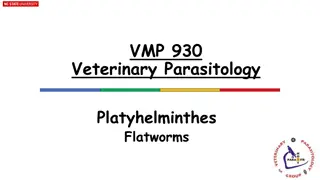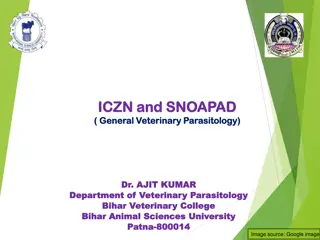Understanding Parasitology: An Introductory Overview by Dr. Saif alshalah
Parasitology, as elucidated by Dr. Saif alshalah, delves into the science of parasites and their impact. This discipline encompasses medical parasitology, the study of parasitic agents causing diseases in humans. The definition and classification of parasites based on their nature, association with hosts, habitat, dependence, and pathogenicity are explored. Additionally, the role of hosts, including definitive and intermediate hosts, in the life cycle of parasites is outlined.
Download Presentation

Please find below an Image/Link to download the presentation.
The content on the website is provided AS IS for your information and personal use only. It may not be sold, licensed, or shared on other websites without obtaining consent from the author. Download presentation by click this link. If you encounter any issues during the download, it is possible that the publisher has removed the file from their server.
E N D
Presentation Transcript
Introduction for parasitology By Dr . Saif alshalah
Definition of Terms Used in Parasitology Parasitology:- is a science that deals with parasites. Medical Parasitology:- Is the study of parasites that causes disease in man. Parasite:- is an organism living temporarily or permanently in or on another organism (host) from which is physically or physiologically dependant upon other. Nature of Parasites- A parasite could be unicellular, worm or an arthropode. Features of Parasites 1. Smaller than their host, 2. Outnumber the host, 3. Short life span than their host, and 4. Have greater reproductive potential than their host.
Association of Organisms When there is an association between two organisms their relation will be one of the following type: 1. Mutualism;- Mutual benefit is derived from the association. 2. Symbiosis:- Permanent association between two different organisms, so dependant on each other, that their life part is impossible. 3. Commensalism:- When the parasite benefited from the host while the host neither benefited nor harmed. 4. Parasitism:-One organism live at the expense of the other, The later usually suffers from the association.
Parasites can be Classified:- I. According to their habitat: 1.Ectoparasites: parasites living on or affecting the skin surface of the host. E.g. lice, tick, etc. 2. Endoparasites: Parasites living within the body of the host. E.g. Leishmania species, Ascaris lumbricoides, etc. II. According to their dependence on the host: 1. Permanent (obligate) parasites: The parasite depends completely upon its host for metabolites, shelter, and transportation. This parasite can not live outside its host. E.g. Plasmodium species, Trichmonas vaginalis, etc. 2. Temporary (facultative) parasite: The parasite is capable of independent existence in addition to parasitic life. E.g. Strongyloids stercolaris, Naegleria fowleri, etc.
III. According to their Pathogenicity: 1. Pathogenic parasites:- It causes disease in the host. E.g., E. histolytica 2. Non-Pathogenic (commensal) parasite:-The parasite derives food and protection from the host without causing harm to the host. E.g. Entamoeba coli 3. Opportunistic parasites:- Parasites which cause mild disease in immunologically healthy individuals, but they cause severe disease in immuno-deficient hosts. E.g. Pneumocystis carnii, Toxcoplasma gondii, Isospora belli
Host :- Hosts are organism which harbors the parasite. Types of Hosts:- 1. Definitive host:- Depending on the parasitic species, it is either a host which harbors the adult stage of a parasite or most highly developed form of the parasite occurs; or sexually mature stages of a parasite and fertilization takes place in it, e.g., man is the definitive host of Taenia saginata. 2. Intermediate host:- Is a host harboring sexually immature or larval stage of a parasite and in which no fertilization takes place in it. E.g. Cow is the intermediate host for Taenia saginata
2.Amplifier host- Intermediate hosts in which parasites under go multiplication. 3. Reservoir host:-A wild or domestic animal which harbors a parasite and acts as sources of infection to humans. 4. Carrier host:- A host harboring and disseminating a parasite but exhibiting no clinical sign. 5. Accidental (Incidental) host:- Infection of a host other than the normal host species. A parasite may or may not continue full development in this host. Vector:- Any arthropod or other living carrier which transports a pathogenicmicroorganisms from an infected to non-infected host. A. Biological vectors:-Those vectors that complete the life cycle a Parasite E.g. Anopheles (Vector of Plasmodium), Phlebotomus (Vector of Leishmania), Glossina (vector of Trypanosoma), Simulium (Vector of Onchocerca), etc. B. Mechanical (Parathenic or transport) Vectors: They are passive carriers of parasites, not essential in the life cycle. E.g. House fly and Chocroach as a mechanical vector for Amoebae, Giardia, etc.
Diagnostic Stage:- A developmental stage of a pathogenic organism that can be detected in stool, blood, urine, sputum, CSF or other human body secretions. Infective Stage:- The stage of parasite at which it is capable of entering the host and continue development within the host. Infection:- Invasion of the body by any pathogenic organism (except )arthropods and the reaction of the hosts tissue to the presence of the parasite or related toxins. Infestation:- The establishment of arthropods upon or within a host. Zoonosis:- Diseases of animals. Today this term is applied for those diseases that are transmittable to man. Biological Incubation (Prepatent) Period:- It is time elapsing between initial infection with the parasite and demonstration of the parasites or their stages in excreta, blood, aspirate and other diagnostic material.
Clinical Incubation Period:- It is the interval between exposure and the earliest manifestation or infestation. Autoinfection:- An infected individual acts as a source for hyperinfection to himself. Superinfection (Hyperinfection):- When an individual harboring the parasite is reinfected by the same parasite. Retroinfection:- Aretrograde infection caused by the newly hatched larva of E. vermicularis from the perianal region to reach the colon, where the adolescent form of the parasite develop.
1.2 Sources of Exposure to Parasitic Infections A. Contaminated soil:- Soils polluted with human excreta is commonly responsible for exposure to infection with Ascaris lumbricoides, S.stercolaris, Trichuris trichuria and hook worms. B. Contaminated water:- Water may contain (a) Viable cysts of Amoeba, flagellates and T. solium eggs, (b) Cercarial stages of human blood fluke, (c) Cyclops containing larva of Dracunculus medinesis, (d) Fresh water fishes which are sources for fish tape worm, and intestinal flukes infection (e) Crab or cray fishes that are sources for lung fluke and (f) Water plants which are sources for Fasciolopsis buski.
C. Insufficiently cooked meat of pork and beef which contains infective stage of the parasite. E.g., Trichenilla spiralis, Taenia species. D. Blood sucking arthropods:-These are responsible for transmission of: e.g., 1. Malaria parasites by female anopheles mosquito 2. Leishmania by phlebotomus 3. Trypanosoma by tsetse fly 4. Wuchreria by Culicine mosquito E. Animals (a domestic or wild animals harboring the parasite), e.g. 1. Dogs are direct sources for human infection with the hydatid cyst caused by E. granulosus and cutaneous larva migrans caused by Toxocara canis, 2. Herbivores animals commonly constitute the source for human infection with Trychostrongylus species. F. Human beings:-Another person his clothing, bedding or the immediate environment that he contaminated are directly responsible for all or a considerable amount of infection with a pathogenic amoeba E. histolytica, E. vermicularis, H. nana . G. Sexual intercourse :- e.g., Trichomonas vaginalis H. Autoinfection :- e.g., S. stercoralis, E. vermicularis, and T. solium























